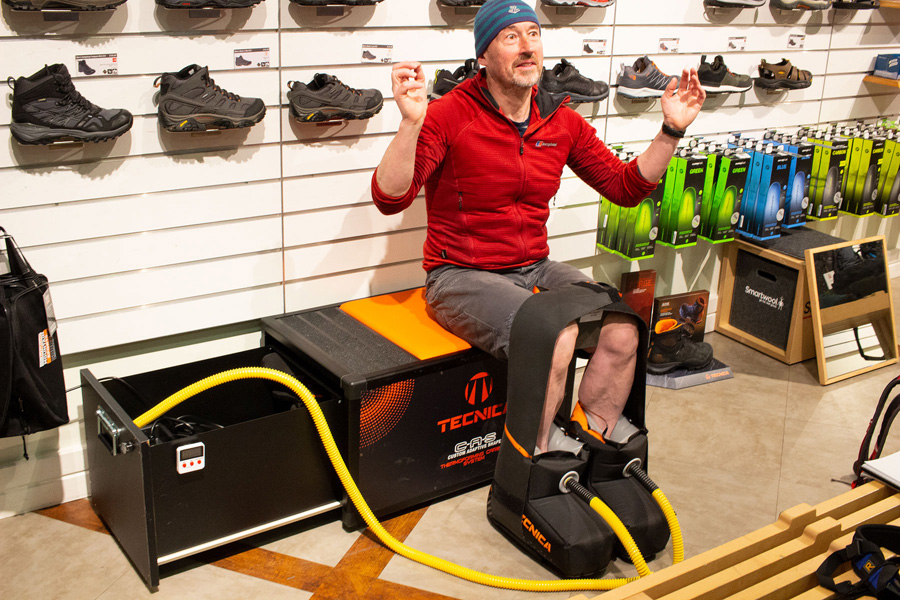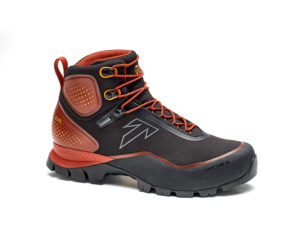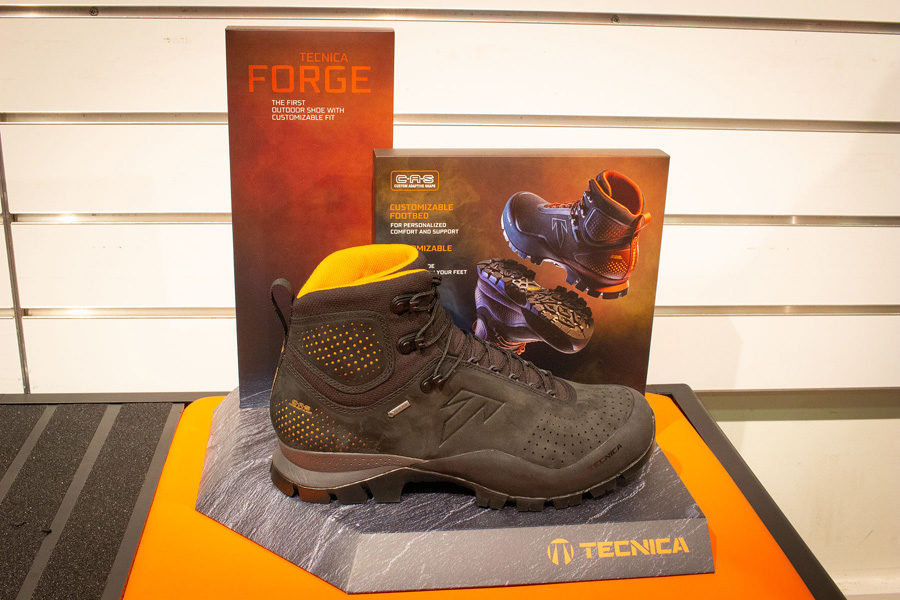I am sat with my knees held carefully apart by a shaped block of foam while a tight strap prevents me from being forcefully ejected from the high-pressure inflatable boots which are shaping a pair of pre-heated Tecnica Forge boots to the exact contours of my feet. Crack Ellis Brigham boot fitter Tom, is fiddling with a box from which emerge bright yellow air hoses. It’s all a little bit Wallace and Grommit. And it isn’t, if you were wondering, particularly comfortable.
The Forge GTX – and its lower-cut shoe equivalent, the Plasma – is claimed to be the first outdoor boot in the world with customisable uppers. The soles are also custom-fitted, but that’s old hat. The CAS – Custom Adaptive Shape – technology is borrowed from Tecnica’s ski-boots and works like this. A special heat-mouldable foam is sited in strategic parts of the boot, the heel area, around the ankle cuff and on the inside of the mid-foot, above the arch. They’re the orange dotted portion of the boot in the images.
Before the customisation process, the boot already had a nice, middle-of-the-road sort of fit comparable to Scarpa or Salomon maybe. Using the Ellis Brigham ramp, I could feel a little heel slip heading ‘uphill’ and some slide on the way back down. Nothing drastic, but definitely there.
The boot, says Tom, is aimed at people who want to get that extra 10% of perfect fit and haven’t quite been able to manage that with an off the peg boot. They might want a slightly snugger heel fit and a little more support at the ankle and arch for example. Or they might have feet with odd little irregularities or differences that mean one foot is slightly different from the other.

Custom fitting is available in selected Ellis Brigham stores, free of charge
The fitting process will be familiar to ski-boot wearers and consists of the insoles and boots being heated either separately or together, then laced firmly in place before feet with boots are placed in those inflatable bags, which in turn press the hot, mouldable foam in to match the exact shape of your feet. Incidentally, you can go back for a remould in the future if you feel it’s necessary – five times or so with leather models, an infinite number with synthetics. Tom looked worried as he told me this.
After several minutes of sitting with your feet being crushed by the air pressure, you’re released into the wild with your newly-customised boots. First impressions? I though the boots were passable before moulding, but afterwards, there was definitely a snugger feeling in the mid-foot, noticeable when pointing ‘downhill’, plus a detectable reduction in heel lift when heading up. It wasn’t a night-and-day revelation, more a subtle, but welcome improvement. The boots felt closer to the sort of near perfect fit I get with one or two brands whose last matches my foot shape most closely. Nice boots to start with, but made a little bit nicer, if that makes sense.
And they are ‘nice boots’. The synthetic uppers feature kevlar reinforced laces, bonded construction and an interesting, single-sided wrap-over, seamless foam tongue. Underfoot they have a Vibram Megagrip rubber outsole and EVA cushioning, plus a ‘just stiff enough’ chassis. Full review to follow.

Tecnica Forge S GTX
The Forge S GTX here retail for £240, so around £40 – £50 more than a non-customisable equivalent I’d say. Is it worth the premium? It’s hard to say at this point – maybe we should have left one boot as standard – but the process does make a detectable difference and, if you’re a footwear perfectionist, with a nagging sense that your mostly middling feet could do better, maybe worth a look. Along with the synthetic-uppered Forge S GTX, there’s also a leather version plus synthetic and leather low-cut Plasma hiking shoes using the same CAS technology.
More info: www.ellis-brigham.com/tecnica






